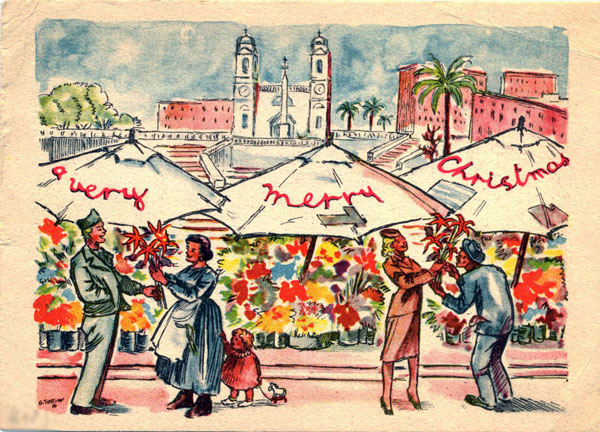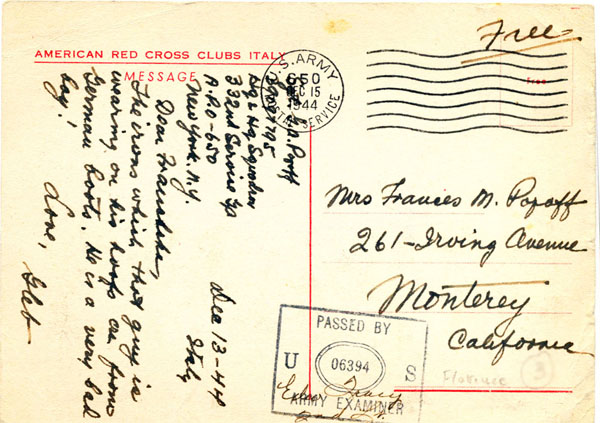| pagina iniziale | le rubriche | storia postale | filatelia | siti filatelici | indice per autori |
1944 - 2014: Un Natale di 70 anni fa
Nei nostri album vi sono vari pezzi che agli occhi di molti collezionisti e amatori sembrano aver ben poco da dire, almeno a prima vista. Il problema risiede nella venalita’ che permea tutto il settore collezionistico: se un pezzo costa parecchio e’ automaticamente raro e interessante e lo si strapaga pur di averlo. Altri collezionisti, invece non hanno fretta e adottano la tattica della tartaruga che va piano e guarda dove va, come va, e cosa fa.
Durante le feste di fine anno si ha un po’ di tempo per mettere in ordine le nostre collezioni e si da anche un’occhiata alle scatole delle scarpe che abbiamo riempito di cianfrusaglie che magari agli occhi di qualche specialista hanno qua e la’ un pezzo di un certo pregio. Poi vi sono i pezzi che indipendentemente dal valore di mercato hanno un certo fascino piu’ o meno celato.
Ed e’ proprio cosi’ che alla vigilia di Natale in uno scatolotto prevalentemente dedicato a pezzi tematici spunta questa cartolina illustrata spedita dal Sergente Popoff del Quartier Generale delle Aviazioni degli Alleati nel Mediterraneo. L’illustrazione e’ opera di G. Tosti che si firma confermando la data 1944, se mai ve ne fosse la necessita’.

La vignetta e’ alquanto affascinante e propone una veduta del mercato dei fiori a Piazza di Spagna con l’inconfondibile e monumentale scalinata centrale e le scalinatelle laterali che portano a Trinita’ dei Monti. La fioraia di destra porge un mazzo di fiori a un poveraccio con le tasche della giacca rovesciate per confermare che sono vuote. L’altra fioraia con la pupa alle calcagna presenta un mazzo di fiori ad un soldato americano con la mano destra nella tasca del giubbetto. Sugli ombrelloni, in bella vista, la scritta "a very Merry Christmas"; l’occhio poi cade sui dettagli come le palme, il cavallino che la fanciullina trascina seco, e – segno dei tempi grami – le pezze e rattoppi sugli ombrelloni. Siamo a Roma e quindi niente neve, niente panettone.
Quando si passa al lato indirizzo e messaggio della cartolina cominciamo a capire che e’ stata creata per le forze armate statunitensi; infatti in alto a sinistra si legge chiaramente “Circoli della Croce Rossa Americana in Italia”.

L’immancabile timbro della censura dell’esercito americano e’ ben piazzato e cosi’ pure il bollo dell’ufficio di posta militare dell’esercito degli Stati Uniti numero 650 che serviva il suddetto Quartier Generale delle Aviazioni degli Alleati nel Mediterraneo giunto a Foggia dalla Tunisia a fine novembre 1943. A meta’ giugno 1944 l’APO 650 seguiva il Quartier Generale a Roma e poi ad agosto un’escursione a Grosseto e ritorno a Roma a fine mese, donde, ai primi di settembre si trasferiva a Firenze dove restava fino a tutto novembre 1945 quando l’APO fu chiuso.
E’ chiaro che il 15 dicembre Popoff spediva alla consorte in California questa cartolina illustrata da Firenze dove questo tipo di cartoline erano giunte per essere distribuite alle forze armate degli Alleati. Nel messaggio, Gleb informa Frances che le placchette dei tacchi degli scarponi del soldato americano che riceve i fiori provengono dagli stivali di un tedesco. Pur nel clima natalizio si sente la necessita’, ben comprensibile, di far sapere ai cari chi sono i vincitori e chi i vinti. Nel mezzo vi stanno gli italiani con le tasche vuote e lo stomaco vuoto, ma almeno con la consolazione di un bel mazzo di fiori e di un sorriso della fioraia che li presenta. Erano questi i giorni dei “Ladri di biciclette” succeduti a quelli ancor piu’ tristi di “Roma Citta’ Aperta”. Settant’anni dopo quel Natale non mi sembra pura coincidenza che ci si scontri con un pezzo come questo che ci riconduce al messaggio che segnalo’ la nascita del Redentore: “Pace in terra agli uomini di buona volonta’” - inestimabile!
ENGLISH VERSION
1944-2014: A SEVENTY-YEAR-OLD MERRY CHRISTMAS
by Giorgio Migliavacca
In our albums there are various items that may appear rather insignificant to many collectors; at a glance they seem to have very little to communicate. The problem lies in the bottom line, acquisitive approach that permeates the collecting world: if an item has a high price it is automatically rare and interesting and some people are prepared to overpay to own it. Other collectors are in no hurry and adopt the modus operandi of the turtle who moves slowly, looks at where she is going, how to make it there, and how to achieve that.
During the year’s end holidays we find some time to put some order in our collections and we even venture to inspect some of the old shoe boxes we filled over the years with pieces of junk that, possibly, to the eyes of a wise specialist may have, here and there, some appeal. Then come the items that, independently from their market value, have a certain charm – sometime concealed, sometime apparent.
It so happened on Christmas Eve, in one of these shoe boxes that provided shelter to various thematic items, out of the blue, there was this illustrated postcard mailed by Sergeant Popoff from the Headquarters of the Mediterranean Allied Air Forces. The view side offers a watercolour by G. Tosti who signed it thereby confirming that it was 1944, if ever there was a doubt. The picture is rather fascinating as it offers a captivating view of the flower market at Piazza di Spagna, in Rome, and in the background the unmistakable monumental Spanish Steps leading to the Trinita’ dei Monti church at the top. The flower lady at right offers a bunch of poinsettias to a poor man whose jacket has the pockets visibly empty. The other flower lady has her child pointing the finger at an American soldier with his right hand in the coatee’s pocket, while the left hand holds the bunch of poinsettias he has just received. The typical large umbrellas display the seasonal greetings message “A very Merry Christmas”; then the eyes move on to the details like the palms, the little horse toy the child is dragging along, and – sign of the sad times – the patches on the big umbrellas. Of course, this is Rome and it is Christmas, therefore no snow, and no Milanese Christmas cake called panettone.
As we flip the postcard, the message side makes it clear that this piece of stationery was created with the USA Armed Forces in mind; at top left we read “AMERICAN RED CROSS CLUBS ITALY”. The familiar “PASSED BY U S ARMY EXAMINER” boxed handstamp confirms the presence of a vigilant eye, and the circle date stamp and wavy lines of the US Army Post Office (APO) 650 provides date of mailing - 15 December 1944 - and validates the postage free status of this piece of mail.
APO 650 served the said Allied Air Forces Headquarters in the Mediterranean. It arrived at Foggia from Tunisia a the end of November 1943; by mid-June 1944 the Headquarters moved to Rome, spending most of August at Grosseto, and then returning to Rome and then, in early September, moving to its final destination in Florence where it remained till the end of November 1945 when the APO was permanently closed.
It is quite safe to say that Popoff sent the postcard from Florence where this type of postcard was widely available to US servicemen. In his message, Gleb informs his wife in California that “the irons which that guy is wearing on his hoofs are from German boots”. Even though it is Christmas time there is the understandable need to inform the dear ones about who were the victors and who were the defeated. In the middle, there were the Italians with empty pockets and most likely a stomach equally empty, but at least with the alleviation of a nice bouquet of flowers and the gentle smile of the flower lady. Those were the days of true great dramas captured by movies like “Rome, Open City” and “Thieves of Bicycles”. Seventy years later it does not seem sheer coincidence that I knocked into a postcard like this which bring us all back to the message that heralded the birth of our Saviour: “on earth peace to people of good will,” – priceless!
| pagina iniziale | le rubriche | storia postale | filatelia | siti filatelici | indice per autori |